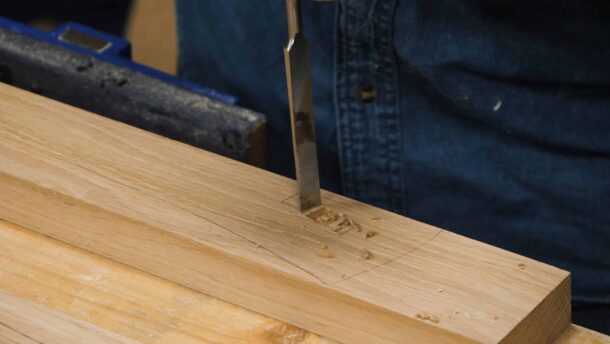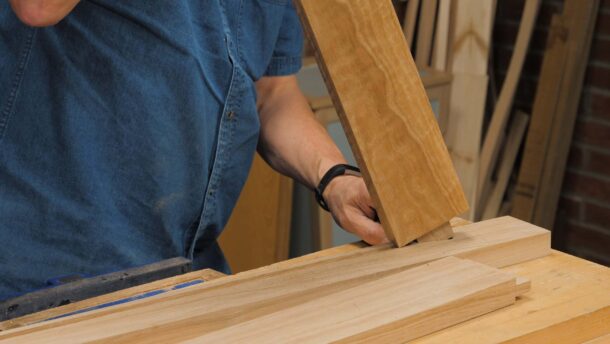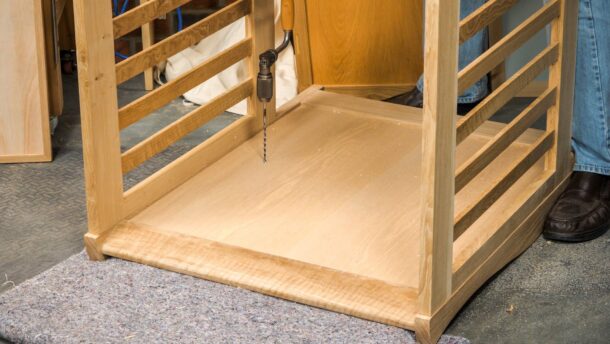Baby’s Cot
Posted 20 December 2018
This is the introductory page for a paid video series. Want to watch more of this project? Select the best option below to get started.
Description
Paul introduces this safe, strong and sturdy cot made to his own design.
Important: Baby safety is a very important issue and many countries and regions have rules on how to keep babies safe. In building this cot we read through our own country’s guidance on this and we have done our best to interpret it and follow it. However, if you build a cot you should do your own research and make sure you follow the relevant guidance. This guidance changes regularly and differs from one place to another. Please do not follow what we have shown without checking it for yourself. The instruction we give should only be used as a starting point for the construction method. Setup, configuration and measurements of the cot you make should be checked to ensure that they are compliant with the guidance relevant to you.
Tool List
- Steel Rule
- Pencil
- PDF template (see technical drawing)
- Gauge
- Tape Measure
- Coping Saw
- Gent Saw (tenon Saw)
- Square
- Knife
- 1/4″, 3/8″, 1″, 1/2″ and 3/4″ Chisel
- Chisel Hammer
- Rasp
- Oil in the Can Oiler
- Spokeshave
- Bench Plane
- Clamps
- Plough Plane
- Router Plane
- Scrub Plane
- Jack Plane
- #80 Scraper
- Drill Brace and Bit
- Card Scraper
- File










Hopefully you will post a photo of her in the Cot, which would just be the icing on the cake 😀
If I made this out of pine would I need to increase the timber dimensions as it is not as dense as oak?
Hi Allen,
Paul says:
No, I made exactly the same one in pine and I use it for my granddaughter.
Kind Regards,
Izzy
Hello team and Merry Christmas!
It would be great for Paul, at some point (perhaps in the introduction) to go through his design considerations.
For example I liked the warnings you gave for the different safety standards, we in the UK have the British Standards office for guidelines on manufacturing specifications. However, was there consideration for the overall height of the mattress for picking up and putting down? My first search on the internet suggested that “some experts advise on bars all the way around for air flow”. Paul went for solid ends. Are dimensions limited by stock selection?…and so on.
I really like everything you are doing. I’m fitting the door to the bathroom cabinet project that I have made out of scraps of wood to the dimensions of the stock I had. These videos have given me the confidence to make furniture of lasting quality for my home.
I am beginning to adapt Paul’s plans i.e. sticking a large version of the tool cabinet on a two drawer chest as a wardrobe.
Design is becoming more and more important to me as I develop my skills.
Regards and, again, Have a Merry Christmas
Rowly
I was attempting to locate safety requirements for baby cribs applicable for the US. Searched for information for almost an hour. I was bounced around through many sites that discussed issuance of new guidelines but could never get to the ASTM standards referenced. The ASTM standard was adopted in 2010 and appears to be the most current. However the ASTM standards are proprietary and require purchase , 50$ for a PDF. I did find a site that does provide some general guidelines and list the Applicable ASTM standards
“Safety standards document that cribs used in facilities should be made of wood, metal, or plastic. Crib slats should be spaced no more than two and three-eighths inches apart, with a firm mattress that is fitted so that no more than two fingers can fit between the mattress and the crib side in the lowest position. The minimum height from the top of the mattress to the top of the crib rail should be twenty inches in the highest position. Cribs with drop sides should not be used. The crib should not have corner post extensions (over one-sixteenth inch). The crib should have no cutout openings in the head board or footboard structure in which a child’s head could become entrapped. The mattress support system should not be easily dislodged from any point of the crib by an upward force from underneath the crib. All cribs should meet the ASTM F1169-10a Standard Consumer Safety Specification for Full-Size Baby Cribs, ”
There is also a standard for Non full sized cribs.
Unbelievable that it is so difficult to obtained detailed info.
Also be aware of mattress safety. Check mattress certification for each manufacturer.
I am very computer literate and actually a retired engineer familiar with ASTM and its standards. Hope someone can possible provide a source for viewing the guidelines.
Gerald,
The standard you seek has been superceded by
ASTM F1169-13 , located in volume 15.11.
Try a large city or university library near you.
Most will have a research section and associated librarian to help.
In my area I use the main Carnegie library in Pittsburgh.
Best,
Craig
Thanks for the info. Especially that the Standard I was looking for had been superceded. I will look in my local University library.
Welcome & Merry Christmas
Craig
Paul, this project is very timely. My niece just had her first baby is July and loves the rocking chair I made for her. In fact, I received a commission to make another for one of her friends. (This is a town in nowhere BC full of beautiful young women who love babies!). I’m really looking forward to making this crib. It will only require one change to comply with our rules, but it’s minor and should pose no problem. Now that you’re in the baby furniture making groove, maybe you could come up with a high chair. I should think between us old grand dads and young fathers your audience would love such a series of baby things. I’m currently researching high chair designs but if one is in your cards would wait to see the masterpiece you would come up with.
I haven’t started my research yet, but can you tell me what the difference you are mentioning is? I too am in BC. (North Saanich). Thanks!
Hi Ian. Sorry for the delay in replying. Our regs indicate only a 1/16th extension past the sides for the corner posts where Pauls are slightly longer. That is, if I’m reading everything correctly. I won’t start my cot until Paul is finished his. I don’t like waiting, I lose the momentum. I’m going to build the bench stool as a preliminary step for a high chair. I’ve received no reply on my query of a possible high chair design so will see if I can come up with one.
Hi, I know the ASTM doc is very specific about the corner post extension limit because of reports of strangulation incident(s) in the past. Any one knows how the 1/16″ limit was arrived at? Wonder whether its just better to aim for corner post flush with the end panel/top rail.
Production team,
Can you tell me how many videos will be in this series? Also will they be $4 each?
This is a very timely project for a addition to my daughter‘s family.
Hi Curt,
There will be 9 episodes in this series.
Each episode is 1 credit, you get 4 credits a month with a paid membership but you can buy them separately for $4 per credit.
Izzy
Thank you.
Hi Paul
Happy belated birthday!
As always this is another great project idea.
You mention at the start about child safety at the forefront and that it is important that all of your loyal followers check with their specific locations regarding the same. It would be helpful if you shared some of those safety guidelines from the UK that you adhered to in deciding on your design and methods you chose in building the baby cot.
Below I have provided a few sites that I found within the US about crib (in US cot in UK..haha) guidelines.
Hope this is helpful and that I get the chance someday to build for my daughter!
https://www.baby-furniture-guides.com/baby-crib-safety.html
http://www.thebabydepartment.com/nursery/crib-safety-standards.aspx
https://www.parents.com/health/parents-news-now/new-crib-safety-guidelines-what-parents-need-to-know/
bob
I am curious about the quality of the lumber Paul uses for prototyping his projects. He talks about using lumber from the local diy center Is it just construction grade 2 x 4’s or …?
Thank you.
Hi Andrew,
Thank you for your comment.
Paul says:
Actually in some ways that’s what it might be described as, however this will depend on which country and even which continent you live on. Here in the UK we can buy similar construction grade lumber to the US, and your question suggests you are in the USA because you use the term lumber. Here we use the term timber. In the UK, we have also access to a pine called Redwood and this is superior to the lumber grade wood you speak of.
Kind Regards,
Izzy
Thanks Izzy. You are correct, I am in the USA.
How is the final assembly of this done? I have some concern about getting it up my stairs and through the nursery door, so I would need to be able to assemble and disassemble it in place.
Hi Steve,
Paul says:
The cot is totally created for flat pack transportation and storage. There are 4 bolts that hold everything together and it is rock solid.
Kind Regards,
Izzy
Hi Paul,
I’m well on the way to completing this project for my first grandchild and thinking about the best child safe coating to use. Can you recommend a product to use (UK) please?
Regards
Dave
@WOODTURNER1967
David,
In the episode 8 comments, Izzy mentions Paul’s choice of finish was a satin water-based furniture varnish by Ronseal.
I just finished my own using an oil-based polyurethane from General Finishes known as Arm-r-Seal, I think that’s available to you in the UK. They also have a water-based version.
Austin,
Thanks. I hadn’t noticed that comment. Is the oil-based Arm-r-Seal child safe too? The images of the tin online state harmful or fatal if swallowed but I assume if you’ve used it on your own once cured it becomes safe?
Yes, after curing the oil-based is just fine for children. The cure time is much longer however (30 days). I used oil-based because I had it on hand and had plenty of time to let it cure.
I’d probably use water-based if I didn’t have finish already in stock, it’s easier to apply and dries more quickly. Paul’s Ronseal isn’t easily available to me in the US, thus my use of Arm-R-Seal.
Austin,
Many thanks for your advice. Very much appreciated
Dave